See Snails? Tree Snails!
By Ruth D’Alessandro, The Wildlife Gardener The Wildlife Gardener has always fantasised about discovering a new species. I suspect that my discovery, should it ever happen, will be not be a new butterfly, moth or beetle but something like the 42nd species of woodlouse, or, if I’m really lucky, a tiny, obscure woodland snail. New species of snail do turn up periodically: the Cliveden snail (Papillifera papillaris) did exactly that in August 2008. As regular readers of Notes From A Wildlife Garden may remember, I then got all excited about a snail by our local mill pond that I’d never seen before. Thrillingly, the same snail expert, Janet Ridout-Sharpe who had verified the Cliveden snail kindly identified my mystery snail as… a fairly common Amber snail (Succinea putris). And I didn’t think about snails much until recently. A warm sunny day and we were walking through local chalk woodland on the North Downs Way. We noticed that several of the sycamore trees had large garden snails and banded snails on their trunks. Looking more closely, I noticed another, small (10-12mm) grey turret-shaped snail. Could this be the undiscovered cousin of the Cliveden snail?
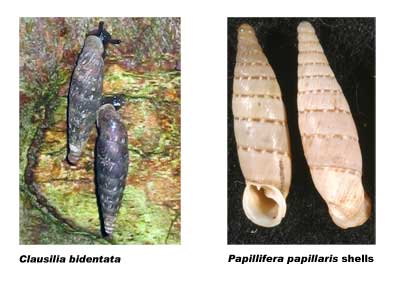
You can see why I was excited. Not having seen a turret-shaped land snail before, my mind raced ahead to that glorious day when I would present my discovery to the Royal Society and be interviewed on Countryfile. I raised my camera, macro setting primed to the small grey creature and… nothing. The battery had gone flat. Would my’new’ species disappear forever into the chalk woodland while I went home and recharged the battery? That night, it rained heavily. And it rained heavily in my heart as I pondered the missed opportunity to photograph an unusual snail. Undaunted, I recharged my camera battery and set off to the chalk woods the next day with Junior Wildlife Gardener no 1. As it happened, a woodland after heavy rain is a much better environment for snail-trailing. We had hardly got into the wood when we started spotting small grey turret-shaped snails. Then we spotted larger (20mm) mahogany-coloured turret-shaped snails as well:
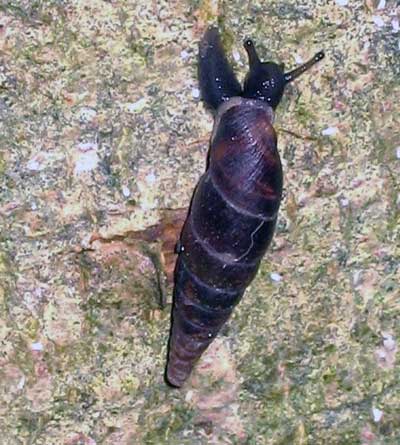
Why did this snail have both head and tail poking out of its operculum at that angle? How on earth does it get about? We soon found the answer:

This looks like an incredibly uncomfortable way of carrying a shell, but as the species is still around, it can’t be disadvantageous to the snail. The wet chalky woodland was snail heaven that day. As I was photographing yet another tiny (6mm) species of turreted snail:
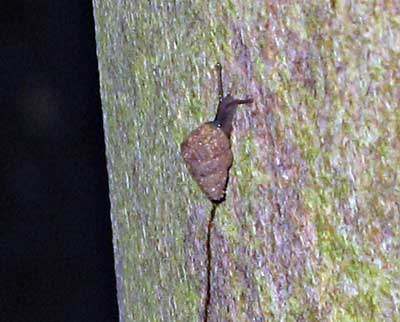
JWG1 cried out,’Mum! Don’t step on that big snail behind you!’ And up until then I had not noticed this magnificent Roman, or Burgundy snail (Helix pomatia) sneaking up behind me and ambling across the chalk path:

So, more previously unseen (by me) snail species than we could ever dream of, in one slippery woodland. What were they all? Martin Harvey of the Open University kindly speculated that the tiny snail could have been a lesser bulin snail (Ena obscura). The wonderful Janet Ridout-Sharpe once again patiently responded to my excited email to her (and recommended a book, the Field Studies Council’s illustrated Land Snails in the British Isles by Robert Cameron and Gordon Riley):
[Re the small grey turret-shaped snails]… I think I’m going have to disappoint you about the Cliveden-like snails. These elongated spindle-shaped snails belong to the family Clausiliidae or door-snails, so-called because they can retract into their shells and close them off with a hinged door-like structure to keep predators out. There are five species native to Britain, not counting the Cliveden snail. I’m almost 100% certain that the snail you have seen on tree trunks is Clausilia bidentata – this is very common in chalk woodlands, where it likes to climb up the trees. It is slightly smaller (9-12 mm) than the Cliveden snail but is otherwise very similar – the most obvious difference is the absence of white spots around the suture line.
However, I might dare to question Janet’s view about the larger mahogany-coloured snails. She says:
[Re the larger mahogany-brown turret-shaped snails]…Cochlodina laminata is also found in chalk woodlands but is larger (15-17 mm) and smooth and chestnut brown, but this species lives in leaf litter and does not like to climb trees.
Following some image research, I still tend towards the view that my mahogany snails are Cochlodina laminata by their size and colour, but against this I can’t avoid the fact that they were most certainly climbing trees, not crawling about in the leaf litter. Perhaps they don’t like climbing trees, but have to. And perhaps I’m wrong about the ID too, as I have been so far in my quest for a new species. But maybe one day, just maybe… STOP PRESS! Since posting this piece, Janet Ridout-Sharpe has confirmed my identifications of Clausilia bidentata and Cochlodina laminata, so no new species to report. Janet also says it is likely that the tiny snail is Ena obscura, although:
…we should now be calling this species Merdigera obscura, a great pity – I think ‘Ena’ suited it well!
Regarding Cochlodina laminata:
I may have misled you a bit about Cochlodina laminata not climbing trees. Mike Kerney, in his ‘Atlas of the land and freshwater molluscs of Britain and Ireland ‘(1999), says ‘in moist weather it may climb weakly up vertical surfaces’, whereas for Clausilia bidentata he says ‘in damp weather it climbs strongly up vertical surfaces’. Well, it’s certainly been moist and damp recently.
And quite extraordinarily, on my picture of the Roman snail, Janet says:
…did you notice the tiny shell just above the big one? It looks rather like an upside-down juvenile Discus rotundatus. Little and Large!
This is the difference between the trained professional and the amateur eye: archaeomalacologist Janet spotted it, Wildlife Gardener didn’t. There is indeed a tiny shell just above Helix pomatia!
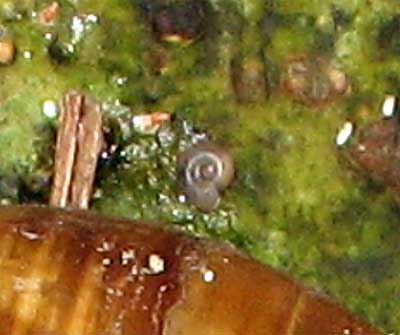
So no new species, but a woodland full of different species of fascinating snail!
- Spurn Spawn! - 26th February, 2014
- Bluebells on wheels: axles of evil? - 2nd February, 2011
- Raising the ba: Wildlife and the Ancient Egyptian Book of the Dead - 8th January, 2011

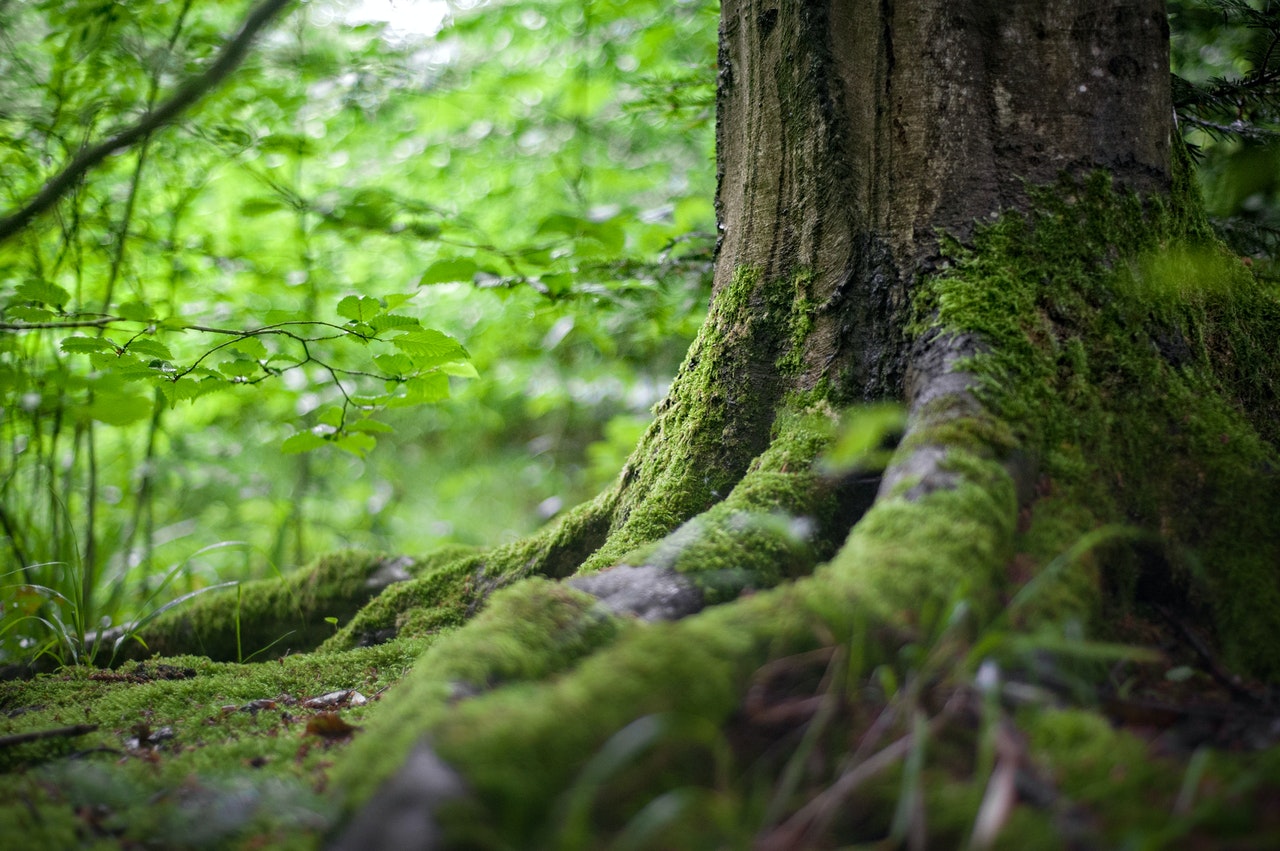
Ha! Steve – of course: Helix/Clausilia/Cochlodina/Merdigera naturenetii!
Fascinating snail-tale!
And presumably you have already named your new discovery in Latin?